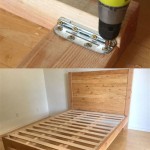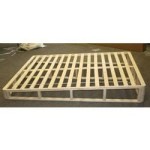How To Make Your Own Bed Railways
Bed railways, also known as bed rails or safety rails, provide support and security for individuals who may experience difficulties getting in and out of bed. They can be particularly helpful for the elderly, people recovering from surgery, or those with mobility issues. While commercially manufactured bed rails are readily available, creating a DIY version can offer a customized solution tailored to specific needs and preferences. This article provides a comprehensive guide on constructing bed rails at home.
Assessing Needs and Planning
Before commencing construction, a thorough assessment of the user's needs and the bed's dimensions is crucial. This includes considering the height, weight, and mobility of the individual who will be using the rails. Measurements of the bed frame are essential to ensure a proper fit. Determining the desired height and length of the rails is also important for optimal functionality and safety. Sketching a design and making a list of required materials can streamline the building process.
Selecting Materials
Choosing appropriate materials is paramount for ensuring the strength and durability of the bed rails. Common choices include wood, metal piping, or PVC. Wood offers aesthetic appeal and can be easily customized, while metal piping provides superior strength and stability. PVC is a lightweight and cost-effective option. The selection should be based on the user's weight, the desired aesthetic, and the available tools and expertise.
Gathering Tools and Equipment
Having the necessary tools and equipment readily available before starting the project will enhance efficiency. Essential tools may include a measuring tape, saw (for wood or PVC), pipe cutter (for metal piping), drill, screws, bolts, and appropriate safety gear such as safety glasses and gloves. The specific tools required will depend on the chosen materials.
Constructing the Rail Frame
The construction process involves creating a sturdy frame that will serve as the foundation for the bed rails. If using wood, cut the pieces to the desired length and assemble them using screws and wood glue. For metal piping, cut the pipes to size and connect them using appropriate fittings and fasteners. PVC construction involves cutting the pipes and connecting them using PVC cement. Ensure all connections are secure and stable to prevent wobbling or collapse.
Attaching the Rails to the Bed Frame
Securely attaching the rails to the bed frame is critical for safety. This can be achieved using brackets, clamps, or straps. The chosen method should be compatible with the bed frame material and design. Ensure the attachment points are strong enough to support the weight of the user leaning on the rails. Regularly inspect the attachments to ensure they remain secure.
Padding and Finishing
Padding the rails enhances comfort and prevents injury. This can be accomplished using foam padding covered with fabric. Securely attach the padding to the rails using staples or adhesive. Consider using a waterproof and easily cleanable fabric for practicality. Finishing touches, such as sanding and painting or sealing the rails, can enhance the aesthetic appeal and protect the materials from wear and tear.
Testing and Adjustments
Once the bed rails are installed, thorough testing is essential. Apply weight to the rails to ensure they can support the intended user. Check for any wobbling or instability. Make any necessary adjustments to the attachments or the rail frame itself to ensure optimal stability and safety. Periodically re-evaluate the rails and make adjustments as needed.
Safety Considerations
Safety should be the paramount concern throughout the entire construction and installation process. Ensure all materials are free of sharp edges or splinters. Regularly inspect the rails for signs of wear and tear. Ensure the rails are compatible with the bed frame and mattress. Consult with a healthcare professional or occupational therapist for personalized recommendations and safety guidelines.
Maintenance and Care
Regular maintenance is essential to ensure the longevity and safety of the bed rails. Periodically check all connections and tighten any loose screws or bolts. Clean the rails regularly using appropriate cleaning products. Inspect the padding for wear and tear and replace it as needed. Address any signs of damage promptly to prevent further deterioration and ensure continued safety.

How To Build A Raised Sleeper Bed Avs Fencing Supplies

Sleepers And Raised Vegetable Beds Railway

Diy Train Table Under Bed Or Sofa For The Home Board Toy

Train Room Diy Wall Tracks Cherish365

Train Room Diy Wall Tracks Decor Bedroom Theme Bedrooms

Build Finescale Model Railway Track Points Crossing

Build An Enchanting Train Bed For Your Little One

Using Railway Sleepers In Your Garden Project Ideas For Homeowners

Wooden Bed For Kids Make Your Own Handmade Hand

Pin On Upcycling
Related Posts







